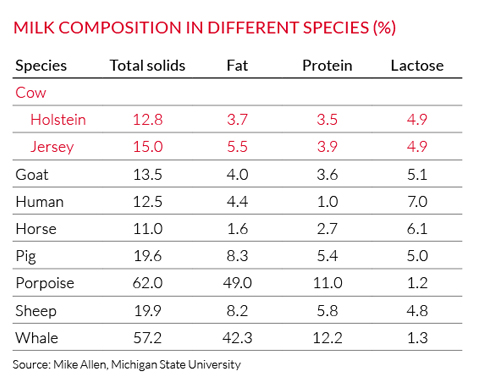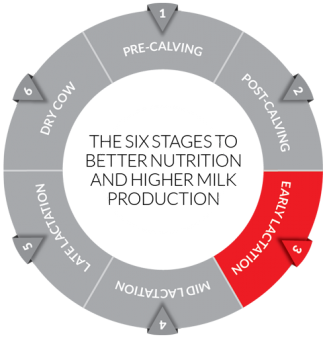Peak Milk Solids Yield
Peak milk solids production occurs when cows are consuming optimal volumes of a high quality ration that delivers the right balance of key nutrients.
At this stage of lactation the all-important milk protein can be manipulated via ration balance, although the upper limit is determined by genotype.
Milk components, including milk protein, are primarily determined by the delivery of blood metabolites to the udder (mammary tissue) over time. Circulating fatty acids, glycerol, amino acids (proteins), acetate, glucose, insulin and minerals are all vital to milk components and are heavily influenced by daily dietary intake.
In broad terms, rations that are high in fibre and low in carbohydrate tend to increase fat percentage but may reduce volume and protein percentage. On the other hand, high carbohydrate, low fibre rations tend to increase volume and protein percentage but reduce fat, provided cows are consuming optimal dry matter intake. The key to making good ration balancing decisions is to focus on total milk solids yield and not percentages or volume in isolation.
Milk volume is primarily driven by blood glucose supply to the udder, with two molecules of glucose required to produce one molecule of lactose. The formation of lactose initiates the process of water being drawn into mammary tissue to maintain osmotic balance, thereby pre-determining milk volume.
Milk fat is derived from a combination of preformed blood metabolites and what is called ‘de-novo’ synthesis, or fat that is produced at the udder. Decreases in milk fat can come from a lack of preformed blood metabolites caused by rumen dysfunction associated with low ration forage to concentrate ratios. A decrease can also be caused by excessive ration unsaturated fatty acid intake (fat content) which can down-regulate enzymes in the mammary tissue responsible for ‘de-novo’ milk fat synthesis. The first is easily addressable; the latter can be far more challenging to recover.
Milk protein is derived from amino acids circulating in the blood supplied to the udder. They require assistance to be transported from blood to milk, and insulin is a key helper. Decreases in milk protein are primarily observed when energy intake is low relative to the stage of lactation and level of production.
For example, fresh cows challenged for energy intake will take amino acids circulating in blood and convert them into blood glucose at the liver to meet energy demands. The reduction in circulating amino acids leads to reduced milk protein. So it is critical to optimise intake as the first port of call to avoid reductions in this valuable milk component. Highly digestible forages and ration components that provide starch will increase blood glucose production and initiate the release of insulin. This protects the amino acids from degradation at the liver and increases insulin supply to mammary tissue to aid milk protein yield.
Monitor 5-7 day trends in milk solids yields per cow and the protein to fat ratio (ideally greater than 0.75:1).
Lower tests don’t necessarily result in lower milk solids yield at peak, as per the example below;

Higher milk solids yield at peak will have a positive bearing on seasonal lactation curves. We can manipulate rations to generate higher value milk solids provided forage intake is optimal and of consistently high quality.

For more information on Peak Milk Solid Yields, talk to your local Ingham Dairy Nutrition Specialist or visit your Fonterra Farm Source or RD1 store.
